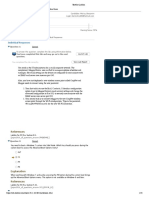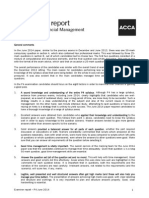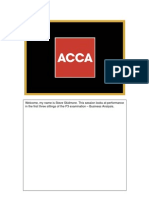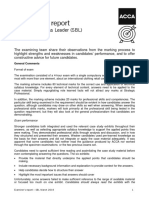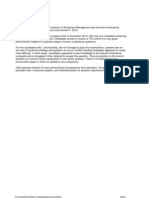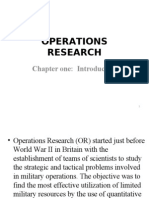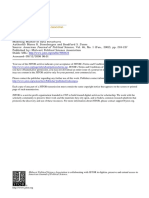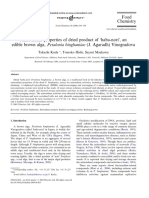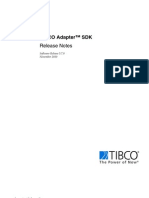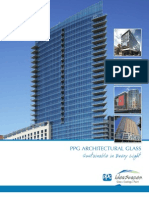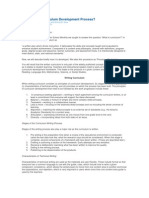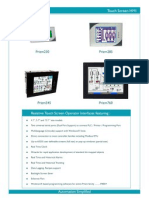p3 Examreport d15
p3 Examreport d15
Uploaded by
wedaje2003Copyright:
Available Formats
p3 Examreport d15
p3 Examreport d15
Uploaded by
wedaje2003Original Description:
Original Title
Copyright
Available Formats
Share this document
Did you find this document useful?
Is this content inappropriate?
Copyright:
Available Formats
p3 Examreport d15
p3 Examreport d15
Uploaded by
wedaje2003Copyright:
Available Formats
Examiner’s report
P3 Business Analysis
December 2015
General Comments
The examination consisted of two sections. Section A contained one question for 50 marks and Section B
contained three questions of 25 marks each, from which candidates had to answer two questions.
Overall, performance in this paper was better than in recent sittings. Many candidates produced very good
answers and there was evidence of good time management, with most candidates fully completing three
questions. Most scripts were well presented and readable.
However, for future reference, candidates are reminded to;
1. Use the quantitative data provided. It is there for a reason and some simple calculations and analysis
will be rewarded.
2. In most questions, only a few marks can be given for theoretical answers. The bulk of the allocated
marks are for the interpretation of the information provided in the scenario in the context of some
theoretical framework.
Specific Comments
Question One
The possible acquisition of a company has been the theme of many P3 questions. The first part of this question
echoed this theme, asking candidates to identify and discuss benefits and advantages of a particular acquisition.
This was worth 19 marks. Many candidates used the SAF framework in their answer (suitability, acceptability
and feasibility). This was perfectly acceptable and generally led to good answers. However, candidates are
reminded that elements of such frameworks are unlikely to be equally balanced in any examination question. So,
there may be little to say about feasibility and a lot to say about suitability. This is usually the case in the real
world as well as in the constrained world of examination questions. This observation is likely to be true of most
frameworks. For example; in a question on Porter’s Five Forces it may be possible to make many points (and so
gain marks) about the potential threat of new entrants. However, there may be less to say about the threat of
substitute products. So always tailor your answer to the balance of points described in the scenario. However,
despite this caveat, overall this part question was well answered by most candidates.
Strategic change, particularly using Balogun and Hope Hailey’s contextual model has also been a regular
question in the past. It was the basis for the second part of the question, worth 15 marks and focused on the
specific contextual features of time, preservation, diversity, capability and readiness. There was one mark
available for an appropriate description of the feature itself, as most are not obvious from their title. So, a
reasonable description of what is meant by time in the Balogun and Hope-Hailey model gained the candidate one
mark. However, beyond this, marks are only given for answers that apply the contextual feature to the case
study. For example; recognising that the reasonable financial state of A2K meant that there was no rush to
implement strategic change, except, perhaps, in recognition of the need to preserve the key training and e-
learning resources. Candidates are reminded that their answers should primarily focus on application,
interpretation and analysis, not the description of features of the model. This part question was not answered
particularly well. Too many candidates are still not familiar with the meaning of the contextual features as
defined by Balogun and Hope Hailey and so rely on ‘common sense’ interpretations that are usually wrong.
Finally, organisational culture is a significant issue in both the evaluation of the acquisition and, if the acquisition
goes ahead, in post-acquisition activity. This was the basis of the final part of this question, worth 12 marks.
Candidates were steered towards two evaluation models; the cultural web and Mintzberg’s organisational
configurations. Generally, candidates were more confident about the cultural web and were able to apply it to the
Examiner’s report – P3 December 2015 1
scenario. Fewer candidates picked up on the implications of the different organisational configurations of the
acquirer and the acquired and the likely problems this would cause. This part question was answered fairly well.
The model answer allowed for a wide range of potential approaches to the discussion of organisational culture.
Four professional marks were available for answers that were clear, had an appropriate tone and vocabulary and
adopted a professional approach.
Question Two
Investment appraisal and its role within the wider business case is recognised in the syllabus. The first part of
this question concerned a critical evaluation of a presented investment appraisal, or cost-benefit analysis. This
critical evaluation was worth 15 marks. The evaluation included marks for the identification of the method being
used (simple payback) and the advantages and disadvantage of this approach to investment appraisal.
Beyond this, candidates were expected to comment on the relevance of the costs and benefits used in the
investment appraisal. For example; they should have recognised that preparation costs are sunk costs and so
should have been omitted from the analysis. Also, the estimated hardware cost should be accurate as it reflects
an estimate prepared by the preferred supplier and so this is likely to be a legitimate, accurate cost in the
investment appraisal. However, too many candidates questioned the actual cost itself. For example; suggesting
that hardware might be cheaper from another supplier and that a proper evaluation of alternatives should be
considered. Thus they were questioning the value of the cost, not the inclusion of the cost in the investment
appraisal. This is the wrong approach and is reminiscent of the faulty evaluation of Critical Success Factors and
Key Performance indicators (KPI) in a previous examination where candidates focused on the value of a
performance objective associated with the KPI (a ROCE of 5% seems very low to me), rather than the usefulness
of the KPI itself. On the positive side, candidates handled benefits a little better, often cross-referencing them to
the classification suggested by Ward and Daniel.
Project management is explicitly considered in the syllabus. Part of project management is project planning, and
this was the focus of the second part of this question worth ten marks. The suggested answer scheme allowed a
wide range of issues to be considered as part of project planning. However, even allowing for this, too many
candidates strayed too far into project conduct, project monitoring and project evaluation. Indeed many described
the whole project life cycle, providing many points that could not be awarded the marks on offer for project
planning. Candidates are advised to read the question carefully and to answer within the scope of the question.
Marks cannot be awarded for answers that are legitimate, but irrelevant in the context of the question.
Examiner’s report – P3 December 2015 2
Question Three
The examination continues to reflect the fact that the analysis and redesign of processes is an important part of
organisational change. The first part of this question, worth 16 marks, was concerned with the diagnosis of
problems in a current business process. Candidates were asked to identify and explore four problems and to
suggest how each of these problems could be addressed. Generally this was well answered. However, two issues
need highlighting.
1) Candidates should ensure that each of their four identified problems is distinct and clearly delimited in
the answer. Numbering each problem would be helpful, or using introductory text such as ‘the first
problem that I have identified is…’
2) Candidates should also recognise that such questions require the application of knowledge, not the
regurgitation of knowledge. Reducing the number of swim lanes (actors) involved in the process is
indeed a legitimate approach to process redesign. However, this has to be presented within the context
of the scenario; for example; ‘removing the administrators from the process reduces the number of actors
involved in the process and this will lead to the following benefits…’
The second part of this question focused on how job redesign is an important part of process redesign. This was
worth nine marks and a wide range of answers was anticipated by the marking scheme and would be given
credit. Unfortunately, candidates did not seem that familiar with this part of the syllabus and so this part
question was not answered particularly well. In fact many candidates just repeated detailed points from their
answer to the first part of the question. Both lecturers and candidates should ensure that all areas of the syllabus
are covered.
Question Four
Environmental threats are particularly significant if the organisation has significant internal weaknesses that make
it vulnerable to such threats. This was the theme of the first part of question four, essentially asking candidates
to explore two quadrants of the SWOT analysis in the context of a proposed divestment. This was worth 15
marks. This was a popular question and was relatively well answered. The only significant point to make is that
candidates should make sure that any threat or weakness is current and is not in the past and as a result is no
longer relevant to the analysis. For example, if a recession is over, then it is no longer a threat.
Organisations giving charitable donations is a controversial issue. Some shareholders believe that such donations
are not in the best interest of the shareholder and also that organizations may not understand the implications of
their benevolence. This was the topic of the second part of this question, worth ten marks. Ethics and corporate
governance are important themes in the ACCA qualification. Many candidates did answer this question relatively
well, quoting appropriate sources. However, too many candidates did little more than repeat the statements
made in the scenario, providing no theoretical context for such positions. Furthermore, many candidates were
unable to coherently put the case for the disgruntled shareholder’s perspective, instead suggesting that he should
accept that the organisation’s donation was beyond questioning or reproach. This part question obviously related
to issues and dilemmas that have been considered in other exams in the ACCA qualification. Candidates should
not shy away from using such knowledge in P3 answers. The examinations are not silos.
Examiner’s report – P3 December 2015 3
You might also like
- L6M2 External ReportDocument1 pageL6M2 External ReportTlotlo RamotlhabiNo ratings yet
- D1 Jul-14 Exam Report FinalDocument4 pagesD1 Jul-14 Exam Report FinalMaciej100% (3)
- PD1 July16 PM ReportDocument9 pagesPD1 July16 PM ReportNyeko Francis0% (1)
- TP 6813Document68 pagesTP 6813Roberto Sanchez Zapata100% (1)
- Rubric TemplateDocument2 pagesRubric TemplateWest NationNo ratings yet
- TestOut LabSim3Document32 pagesTestOut LabSim3Anonymous 4qjnv0BsNo ratings yet
- Addison Wesley LongmanDocument7 pagesAddison Wesley LongmanJose Alberto Tovar MorenoNo ratings yet
- Ip NewDocument17 pagesIp NewNiket Gandhir89% (9)
- Examiner's Report: June 2013Document3 pagesExaminer's Report: June 2013wedaje2003No ratings yet
- P3: B A D 2007 - E ' R: Usiness Nalysis Ecember Xaminer S EportDocument3 pagesP3: B A D 2007 - E ' R: Usiness Nalysis Ecember Xaminer S EportKhurram AzizNo ratings yet
- Examiner's Report: March 2016Document3 pagesExaminer's Report: March 2016Syed Abdur Rahman GillaniNo ratings yet
- 1210 p3 (1) Examiner's ReportDocument3 pages1210 p3 (1) Examiner's ReportvasaBKNo ratings yet
- Apm Examreport m19Document4 pagesApm Examreport m19para johnsonNo ratings yet
- Examiner's Report: March 2019Document4 pagesExaminer's Report: March 2019Наиль РизвановNo ratings yet
- June 2011-Exam CommentsDocument3 pagesJune 2011-Exam CommentsShakeel ShahzadNo ratings yet
- Business ManagementDocument4 pagesBusiness ManagementabdullahNo ratings yet
- p5 Examreport d13Document5 pagesp5 Examreport d13Sikander KhanNo ratings yet
- P3 December 2009 Examiner ReportDocument3 pagesP3 December 2009 Examiner ReportKhurram AxENo ratings yet
- Dec2015 - F1.exam ReportDocument3 pagesDec2015 - F1.exam ReportChaiz MineNo ratings yet
- Examiner's Report: September 2019Document5 pagesExaminer's Report: September 2019Наиль РизвановNo ratings yet
- Business Management Behavioural StudiesDocument5 pagesBusiness Management Behavioural StudiesMohayman AbdullahNo ratings yet
- Examiner's Report: F1 Accounting in Business June 2011Document3 pagesExaminer's Report: F1 Accounting in Business June 2011Ahmad Hafid HanifahNo ratings yet
- p7 Examreport d15Document4 pagesp7 Examreport d15shahranhabeebNo ratings yet
- Business ManagementDocument4 pagesBusiness ManagementabdullahNo ratings yet
- f1 Fab Examreport j17Document4 pagesf1 Fab Examreport j17muhammad aliNo ratings yet
- Examiner's Report 0611 - p4Document4 pagesExaminer's Report 0611 - p4Duc Anh NguyenNo ratings yet
- Examiners' Report: F1 Accounting in Business December 2008Document3 pagesExaminers' Report: F1 Accounting in Business December 2008bony_thomasNo ratings yet
- APM Examiner's Report M20Document5 pagesAPM Examiner's Report M20Наиль РизвановNo ratings yet
- f1 Fab Examreport d16Document4 pagesf1 Fab Examreport d16sraoaccaNo ratings yet
- Examiner's Report: June 2014Document4 pagesExaminer's Report: June 2014ZhareenmNo ratings yet
- Examiner's Report: June 2019Document7 pagesExaminer's Report: June 2019Sofiya BayraktarovaNo ratings yet
- Examiners' Report Principal Examiner Feedback January 2020Document6 pagesExaminers' Report Principal Examiner Feedback January 2020DURAIMURUGAN MIS 17-18 MYP ACCOUNTS STAFF100% (1)
- Panelists Report Mod B Dec 18 FinalDocument5 pagesPanelists Report Mod B Dec 18 FinalConnieChoiNo ratings yet
- Examiner's Report: P5 Advanced Performance Management December 2011Document4 pagesExaminer's Report: P5 Advanced Performance Management December 2011aarzeenabmNo ratings yet
- f1 Fab Examreport j15Document4 pagesf1 Fab Examreport j15zaraNo ratings yet
- ExaminerReport 5UIBP November2022 0Document6 pagesExaminerReport 5UIBP November2022 0Yan Myo ZawNo ratings yet
- f1 Examreport j12Document4 pagesf1 Examreport j12Msu RabbyNo ratings yet
- CIPS Exam Report For Learner CommunityDocument5 pagesCIPS Exam Report For Learner Communityjoyce chitakaNo ratings yet
- Welcome, My Name Is Steve Skidmore. This Session Looks at Performance in The First Three Sittings of The P3 Examination - Business AnalysisDocument20 pagesWelcome, My Name Is Steve Skidmore. This Session Looks at Performance in The First Three Sittings of The P3 Examination - Business AnalysisThang NguyenNo ratings yet
- L3D5 - Examiner Report March 2016Document5 pagesL3D5 - Examiner Report March 2016Marlon FordeNo ratings yet
- Examiner's Report: Advanced Performance Management (APM) July 2020Document7 pagesExaminer's Report: Advanced Performance Management (APM) July 2020Наиль РизвановNo ratings yet
- SBL Examreport m19Document9 pagesSBL Examreport m19NebiyuNo ratings yet
- Cape 2007 MobDocument7 pagesCape 2007 MobStacy Ben0% (1)
- Examiner's Report: F8 Audit and Assurance June 2011Document7 pagesExaminer's Report: F8 Audit and Assurance June 2011xiddiquiNo ratings yet
- Report On The ExaminationDocument8 pagesReport On The ExaminationJR DrawerNo ratings yet
- f4 Glo Examreport j15Document3 pagesf4 Glo Examreport j15Leonard BerishaNo ratings yet
- f4 Glo Examreport j17Document3 pagesf4 Glo Examreport j17liselichweweNo ratings yet
- P3 PEG Final For WebsiteDocument10 pagesP3 PEG Final For Websiteiconoclast500No ratings yet
- D1 Jan15Document5 pagesD1 Jan15Maciej100% (2)
- f8 Examreport m17Document7 pagesf8 Examreport m17Omar FarukNo ratings yet
- Examiner's Report: June 2014Document7 pagesExaminer's Report: June 20141707892No ratings yet
- CIPS Exam Report For Learner Community:: Question 1 - Learning Outcome 1Document4 pagesCIPS Exam Report For Learner Community:: Question 1 - Learning Outcome 1AMariDanaNo ratings yet
- Examiner's Interview: F1 - Accountant in Business: Business. The Examiner, Bob Souster, Has Provided The Answers and HisDocument12 pagesExaminer's Interview: F1 - Accountant in Business: Business. The Examiner, Bob Souster, Has Provided The Answers and HisKhurram AzizNo ratings yet
- Examiner's Report: F1 & FAB PapersDocument5 pagesExaminer's Report: F1 & FAB PaperssraoaccaNo ratings yet
- APM SD20 Examiner's ReportDocument13 pagesAPM SD20 Examiner's ReportMota Tess TheressaNo ratings yet
- E2 March 2011 PegDocument12 pagesE2 March 2011 PegAman ThindNo ratings yet
- Business Studies: Paper 7115/11 Short Answer/Structured ResponseDocument13 pagesBusiness Studies: Paper 7115/11 Short Answer/Structured Responsemstudy123456No ratings yet
- Examiner's Report: P7 Advanced Audit and Assurance December 2017Document4 pagesExaminer's Report: P7 Advanced Audit and Assurance December 2017Lukas CNo ratings yet
- Pearson LCCI Certificate in Management Accounting (VRQ) Level 4Document17 pagesPearson LCCI Certificate in Management Accounting (VRQ) Level 4Aung Zaw HtweNo ratings yet
- Auditing: Examination Papers and Examiners' ReportsDocument7 pagesAuditing: Examination Papers and Examiners' ReportsChloe ThamNo ratings yet
- 5HRD Examiner'SReport SuggestedAnswers 12.13Document20 pages5HRD Examiner'SReport SuggestedAnswers 12.13Myat Zar GyiNo ratings yet
- Examiner's Interview 2009: F1 - Accountant in BusinessDocument16 pagesExaminer's Interview 2009: F1 - Accountant in Businessriyaz_sandNo ratings yet
- SBL Examreport s19Document9 pagesSBL Examreport s19KubNo ratings yet
- Roadmap to Cima Gateway Success: Roadmap to help you pass your CIMA Gateway exams - A practical guide: Roadmap to help you pass your CIMA Gateway exams - A practical guideFrom EverandRoadmap to Cima Gateway Success: Roadmap to help you pass your CIMA Gateway exams - A practical guide: Roadmap to help you pass your CIMA Gateway exams - A practical guideNo ratings yet
- Employee Surveys That Work: Improving Design, Use, and Organizational ImpactFrom EverandEmployee Surveys That Work: Improving Design, Use, and Organizational ImpactNo ratings yet
- Guidance On How To Close A USAID Mission - Checklists: I. GeneralDocument41 pagesGuidance On How To Close A USAID Mission - Checklists: I. Generalwedaje2003No ratings yet
- P3 Business Analysis - : A Guide To Using The Examiner's ReportsDocument11 pagesP3 Business Analysis - : A Guide To Using The Examiner's Reportswedaje2003No ratings yet
- P3 Business Analysis - : A Guide To Reflection For Retake StudentsDocument13 pagesP3 Business Analysis - : A Guide To Reflection For Retake Studentswedaje2003No ratings yet
- P3 LSBF Study Plan - Dec 2015 - 2p PDFDocument2 pagesP3 LSBF Study Plan - Dec 2015 - 2p PDFwedaje2003No ratings yet
- P3 Acowtancy Notes - 186pDocument186 pagesP3 Acowtancy Notes - 186pwedaje2003No ratings yet
- P3 Short Notes 2018 - 47pDocument47 pagesP3 Short Notes 2018 - 47pwedaje2003No ratings yet
- P3 BPP Mock Exam Jun-2010 PDFDocument28 pagesP3 BPP Mock Exam Jun-2010 PDFwedaje2003No ratings yet
- P1 Internal StakeholdersDocument12 pagesP1 Internal Stakeholderswedaje2003No ratings yet
- P1 Internal StakeholdersDocument12 pagesP1 Internal Stakeholderswedaje2003No ratings yet
- P1 CC 1 Final VersionDocument28 pagesP1 CC 1 Final Versionwedaje2003No ratings yet
- Legal Framework For Hiring and Managing Employees in EthiopiaDocument6 pagesLegal Framework For Hiring and Managing Employees in Ethiopiawedaje2003100% (1)
- 3 Internal Audit ManualDocument33 pages3 Internal Audit Manualsherif76No ratings yet
- Cover LettersDocument5 pagesCover Letterswedaje2003No ratings yet
- Resume CoverLetterAccountingDocument5 pagesResume CoverLetterAccountingwedaje2003No ratings yet
- Operations Research: Chapter One: IntroductionDocument16 pagesOperations Research: Chapter One: Introductionwedaje2003No ratings yet
- Dividend Policy Determinants: An Investigation of The Influences of Stakeholder TheoryDocument18 pagesDividend Policy Determinants: An Investigation of The Influences of Stakeholder Theorywedaje2003No ratings yet
- The Impact of International Trade Law On EnvironmentDocument9 pagesThe Impact of International Trade Law On EnvironmenthoneyNo ratings yet
- 03.24.steenbergen JonesDocument21 pages03.24.steenbergen JonesINDI TI Soluções em TecnologiaNo ratings yet
- Food Chemistry: Takashi Kuda, Tomoko Hishi, Sayuri MaekawaDocument6 pagesFood Chemistry: Takashi Kuda, Tomoko Hishi, Sayuri MaekawaMutiara RahmawatiNo ratings yet
- Introduction To Consumer Behaviour FinalDocument11 pagesIntroduction To Consumer Behaviour FinalMohammadSaleem100% (2)
- Archmodels v004 PDFDocument6 pagesArchmodels v004 PDFGabriela López TelloNo ratings yet
- Tarnish & CorrosionDocument48 pagesTarnish & CorrosionmujtabaNo ratings yet
- Promax 2D Seismic Processing and Analysis: 626080 Rev. B May 1998Document47 pagesPromax 2D Seismic Processing and Analysis: 626080 Rev. B May 1998Belghali BibaNo ratings yet
- UCAS Materials Science Personal StatementDocument2 pagesUCAS Materials Science Personal Statementaantia50% (2)
- TIBCO Adapter™ SDK: Release NotesDocument56 pagesTIBCO Adapter™ SDK: Release NotesAndy LuNo ratings yet
- Segmentation:: Reference: Marketing Survey by National Handloom Development CorporationDocument7 pagesSegmentation:: Reference: Marketing Survey by National Handloom Development CorporationdNo ratings yet
- SSC GD Paper 2021 in English Set 36Document33 pagesSSC GD Paper 2021 in English Set 36zeba kousarNo ratings yet
- Index CustodesDocument9 pagesIndex CustodesBen ZagamiNo ratings yet
- Agni College of Technology: Office of Examcell Model ExaminationDocument2 pagesAgni College of Technology: Office of Examcell Model ExaminationScientist SakthivelNo ratings yet
- Superman All StarsDocument31 pagesSuperman All StarsDaniel CostaNo ratings yet
- Oral Communication First Quarter Summative TestDocument4 pagesOral Communication First Quarter Summative TestClarice Buga-ayNo ratings yet
- The Nyaya DarshanaDocument106 pagesThe Nyaya Darshanasimhan743640No ratings yet
- Sustainable in Every Light: PPG Architectural GlassDocument36 pagesSustainable in Every Light: PPG Architectural GlassWanda VélezNo ratings yet
- What Is The Curriculum Development ProcessDocument3 pagesWhat Is The Curriculum Development ProcessZ_Z_Z_ZNo ratings yet
- PZM TouchscreenDocument4 pagesPZM TouchscreenRajesh Selva RajNo ratings yet
- Class Diagram of Property Management System PDFDocument1 pageClass Diagram of Property Management System PDFJordanianNo ratings yet
- Influence of Different Angles of Reciprocation On The Cyclic Fatigue of Nickel-Titanium Endodontic InstrumentsDocument4 pagesInfluence of Different Angles of Reciprocation On The Cyclic Fatigue of Nickel-Titanium Endodontic InstrumentsPaola AndreaNo ratings yet
- 8086 Microprocessor RajDocument86 pages8086 Microprocessor RajVenkata Rajkumar ChNo ratings yet
- Deloitte AnalyticsDocument5 pagesDeloitte Analyticsapi-89285443No ratings yet
- SSM College of Engineering and Technology: Seminar ReportDocument9 pagesSSM College of Engineering and Technology: Seminar ReportNaveed BeighNo ratings yet
- Commission On Higher Education: Ms. Charisse F. MartinDocument34 pagesCommission On Higher Education: Ms. Charisse F. MartinCharisse MartinNo ratings yet





